An old man, a mountain, a dance and the rain…Inside Njelele’s sacred rain-making ceremony
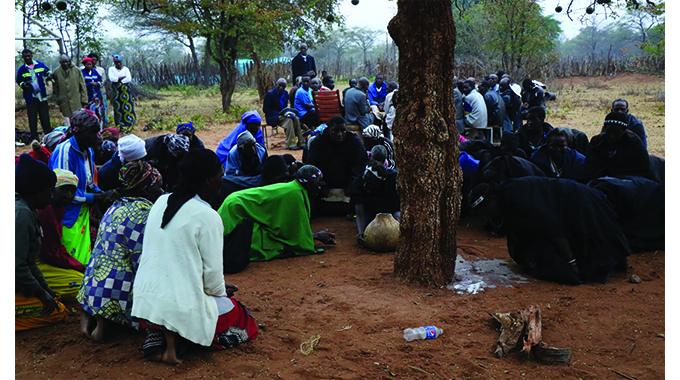
Bongani Ndlovu, Chronicle Reporter
IT was a rain shower that hit the parched ground in the Tsholotsho District that some will attribute to the beginning of the rainy season, but for others in the know, it was an assurance that the gods have heard their prayers.
This was the culmination of a three-day interceding rainmaking ceremony by a group of AmaHosana from the area of Matabeleland North province. The rain poured down at Chief Tategulu’s homestead and whole area. This was the tell-tale sign that all shall be well in the next coming cropping season.
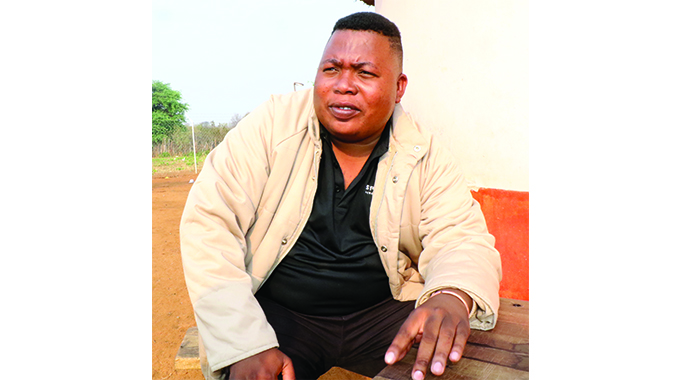
Any other human being, who is not well versed or believes in this ceremony will just say it was a coincidence that it rained on the day the rain priests – as the AmaHosana are known – returned from Njelele Shrine, in Matobo, Matabeleland South province.
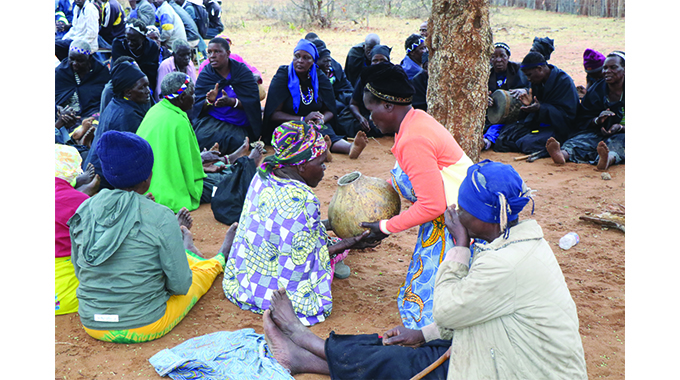
villagers from Chief Tategulu drink traditional opaque beer during the rain making ceremony
The Njelele Shrine is a cave which is of significant spiritual importance in Zimbabwe; pilgrims visit it annually for ritual purposes before the beginning of the rain season. The shrine is popularly known as Njelele, a Tjikalanga term which refers to a certain type of bird. In Shona it is known as Mabweadziva which means the place of spring waters. This explains why Njelele is believed to be the rain-making shrine. Another Tjikalanga name for the shrine is “Malindidzimu”, which means “The Sacred Place for Our Ancestors”. Njelele is also known as Matonjeni.
Chief Tategulu and AmaHosana made the pilgrimage to the shrine on Saturday and spent the whole of Sunday singing and dancing, and returned on Monday to his homestead.
Another round of singing, dancing and drumming happened on Monday night, the whole day until Tuesday evening and the heavens opened up.

Rain making ceremony
At the crack of dawn on Wednesday, the thumping of drums started. A group of about 20 people dressed in black, each with bangles on their feet and wrists gathered around a fire.
This marked the last leg of the rainmaking ceremony, as the AmaHosana, village heads, headmen and Chief Tategulu made their way to an Umkhemeswane tree (Monkey Orange) which is in the homestead.
As the AmaHosana got closer to the tree, there was an invisible demarcation that whoever entered it should know that it was holy ground. It was only the AmaHosana who entered this invisible holy ground, removing their shoes and congregating around the tree.

Then the drums started beating, then rhythmic clapping as traditionally brewed beer in iqhaga was poured at the base of the tree by one of the AmaHosana.
She went into a trance, jerking her head up and down, while her body followed, and with her head, would dip it into the beer that was poured at the base of the tree.
Chants of words like Shoko or Thobela from her peers would be used in between requests for Amazolo (rain). The traditional beer was then shared around with the villagers.
At the end of it all, the procession went back to Chief Tategulu’s homestead, singing, “Amnandi amabele, siyawagaya amabele.”
This whole process made believers of villagers such as Mr Ian Warren Nsukuzonke Moyo.

AmaHosana perform rituals during a rain-making ceremony held at Chief Tategulu’s homestead in Tsholotsho
“I’m 65 years now, and I have never seen the rain coming down. What I saw made me a believer
Such ceremonies are very important for us as a people. This is the first time in a long time that this has been done. I commend Chief Tategulu that he brought this tradition back,” said Mr Moyo.
He said when he heard insingizi (hornbill, also known as rain birds) tutting on Friday he was at first dismissive, but when they did the same on Saturday through Sunday, he started to have a change of thought.
“When I got here (Chief Tategulu’s homestead), on Friday the first sign something was going to happen was the striking calls of insingizi in the distance. On Saturday morning they started calling again, and this was strange as it was hot and for these birds to start singing it was unusual,” said Mr Moyo.
He said when AmaHosana left on Sunday for Njelele some stayed at the chief’s homestead.
“They were singing, dancing and playing the drums the whole night. When the group from Njelele returned on Monday, the clouds started gathering and in no time the sky was covered by the time it was Monday night.
Towards the evening, although it was cloudy, there was a hot flash and for me, this signalled that rain was coming. I saw lightning and heard thunder and in no time, raindrops started falling and we had a shower for some time,” said Mr Moyo.
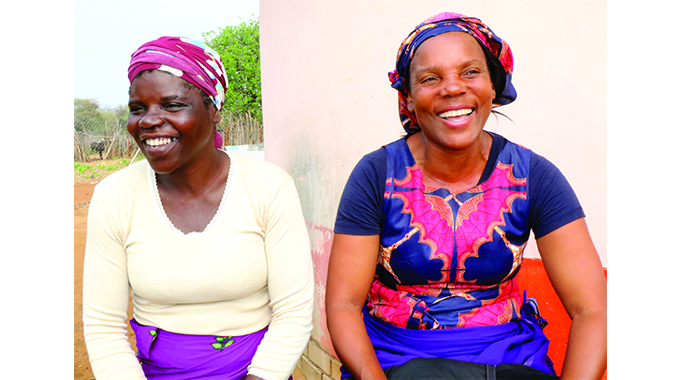
Another villager, Ms Siqondile Moyo said the rain on Tuesday was an assurance that the heavens will pour out abundant blessings in the form of rains.
“This traditional ceremony is very important as we haven’t had good rainfalls over the years. The ceremony has been done, and we witnessed the rains after coming from Njelele. We are now hopeful that this season we shall have good rains because of this traditional ceremony,” said Ms Moyo.
Ms Sithembinkosi Ndlovu said she is leaving her religion and going back to her traditions.
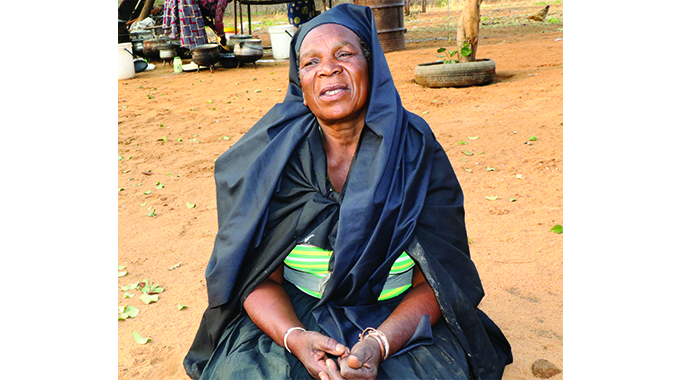
“As a people, we may be churchgoers, but I think we are lost and we have to return to our traditions. I’m a firm believer of this because, before this ceremony, it was extremely hot and now, I’m surprised that we are wearing jerseys,” said Ms Ndlovu.
One of the AmaHosana, Ms Lucia Moyo, known as Gogo maNyathi said the significance of pouring traditional beer at the base of the tree was to show ancestors that they are still practising the rites.
“When we are about to finish the traditional ceremony, we wake up in the morning and play drums and sing to a sacred tree that is in his compound. The tree is called umtamba (monkey orange). People have been instructed not to climb so that they don’t disturb its growth.

“Also, when we are about to finish the traditional ceremony, there’s iqhaga lotshwala which is brewed traditionally and poured on the tree. This will be us talking to the ancestors, telling them that we are still following the traditions they left all those years ago.”
Gogo maNyathi explained what happens at the Njelele shrine.
“When we get to Njelele, an old man will take us up the mountain. Before that we tell him where we are from and that sizocela amazolo. We enter the cave and we start asking the spirits for rain and tell them that the earth is dry and our livestock are dying because of the lack of water.
“We dance the night away dressed in these black clothes and in the morning, we return to our villages and the ceremony continues.”

Ms Lucia Moyo, a Hosana
Chief Tategulu said he was a firm believer in the traditional rites of people hence he decided to revive the practice in his area.
“This is the tradition that is there for every tribe, but there are some chiefs that don’t practise it because they are now Christians. We have been at Njelele from Friday with AmaHosana and when we returned to my area, some were travelling there to ask for the rain,” said Chief Tategulu.
After the ceremony was over, villagers gathered at Chief Tategulu’s homestead and ate braaied meat and some drank tea as they prepared to return to their various homesteads.
Rainmaking is something that many believe in while some do not. The events that happened at Chief Tategulu’s area might have been a coincidence, but what was sure was that when the AmaHosana danced on Tuesday, the clouds gathered and the heavens opened up and quenched the dry soil in the area. – @bonganikunzi


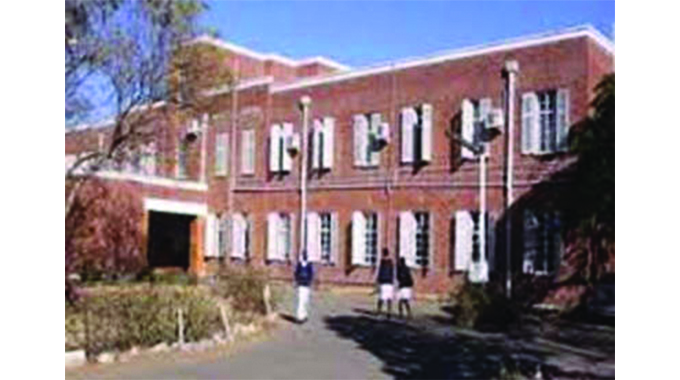
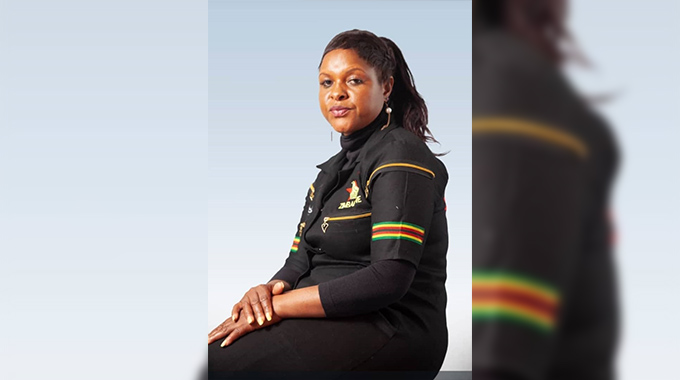
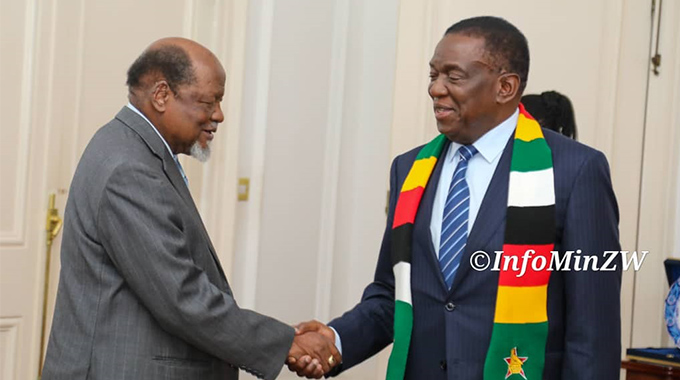







Comments